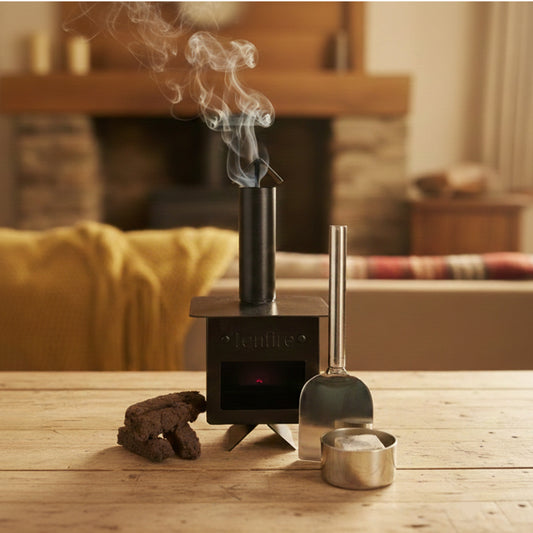
The Health Benefits of Natural Candles
By Dawn, Founder of Tenfire
Natural candles do more than scent a room. They shift the atmosphere, change how we feel, and—even if only for a moment—bring us back to ourselves.
As the founder of Tenfire, I’ve seen the quiet power of candles firsthand. They calm a space. They soften the mood. And when they’re made from natural, safe ingredients, they do so without filling your home with unnecessary chemicals.
This guide explores the health benefits of natural candles—and why these simple flames can be so good for you.
TL;DR – Are Natural Candles Good for You?
- Yes. They create a calming environment, support relaxation, and don’t release harsh chemicals
- Natural waxes like soy, beeswax, or coconut burn cleaner than paraffin
- Plant-based fragrance oils offer subtle aromatherapy benefits
- The ritual of lighting a candle encourages mindfulness and deep breathing
- Choosing biodegradable wax supports sustainable, low-tox living
What Are Natural Candles?
Natural candles are made from waxes and ingredients that come from plants or other naturally occurring sources—without synthetic fillers, dyes, or petroleum-derived compounds.
Common natural waxes:
- Soy wax – derived from soybeans, renewable and biodegradable
- Beeswax – non-toxic and slightly honey-scented
- Coconut wax – clean-burning and soft-textured
Natural candles often also use:
- Wooden or cotton wicks
- Essential oils or phthalate-free fragrance blends
1. A Gentle Ritual
Lighting a natural candle isn’t just an action—it’s a moment.
You strike the match. You pause. You focus on the flame catching, the wax warming, the scent slowly rising. That moment is a cue to arrive—mentally, emotionally, and physically.
Even just one intentional light can:
- Signal the start of your evening
- Help set the tone for a task or creative flow
- Mark a boundary between work and rest
2. Calming Glow for Stress Relief
The flicker of candlelight can soothe the nervous system. Compared to harsh blue or overhead light, the warm glow of a candle helps:
- Slow your breathing
- Lower your heart rate
- Reduce cortisol (the stress hormone)
Watching a flame move quietly—without a screen—calms the mind. A few minutes of “candle gazing” is even used in some meditation practices.
3. Subtle Aromatherapy
Unlike artificial candles that overpower a room, natural wax carries fragrance gently.
Some popular scents for well-being include:
- Lavender – calming, soothing
- Eucalyptus – clears the mind
- Citrus – energising and mood-lifting
- Cedarwood – grounding
The goal isn’t to flood the air—it’s to support your mood and breathing.
4. Anchoring the Breath
Try this quick mindfulness practice:
- Light a candle
- Take three deep, slow breaths
- As you exhale, soften your gaze on the flame
- Let any racing thoughts settle
The candle becomes a focal point—something to return to when your mind drifts. It’s a simple, physical way to start meditating or simply pausing.
5. A Sustainable Mindset
Natural candles don’t just benefit your health—they align with eco-conscious living.
- Soy and coconut waxes are biodegradable and renewable
- Beeswax supports small-scale beekeepers
- Minimal packaging often comes with artisan or natural candle brands
Choosing these kinds of candles is a small way to bring intention into your space—and lessen your home’s environmental load.
Why Wax Type Matters
Candles made from paraffin wax—a petroleum by-product—can release:
- Toluene
- Benzene
- Black soot
These are linked to indoor air pollution and are best avoided if you burn candles regularly.
Natural waxes burn:
- More slowly
- With less soot
- Without releasing petrochemicals
They’re better for your space, your lungs, and your surfaces.
Why Clean Fragrance Is Important
Many mass-market candles use synthetic fragrance oils containing:
- Phthalates (linked to hormone disruption)
- Undisclosed irritants that can cause headaches
In contrast, quality natural candles use:
- Essential oil blends
- Phthalate-free fragrance oils
- Transparent ingredient listings
The result? Fragrance that enhances your space—without irritating your body.
Candles That Are Good for You vs. Candles That Aren’t
Candles that are good for you:
- Soy, beeswax, or coconut wax
- Cotton or wooden wicks
- Minimal soot and no smoke
- Essential or phthalate-free fragrance
- Recyclable or reusable containers
Candles that aren’t:
- Made from paraffin
- Use metal-core or unidentified wicks
- List only “fragrance” with no ingredients
- Burn fast, hot, or smoky
If it smells overpowering or gives you a headache—it’s not doing your body any favours.
Creating a Candle Ritual at Home

Even a 5-minute ritual can shift your day:
- Light your candle
- Brew a tea
- Sit quietly and breathe
- Write down one thing you’re grateful for
Small acts of care compound. The candle becomes a reminder: you get to slow down.
What We Use at Tenfire (and Why)
At Tenfire, every candle is:
- Made with 100% soy wax
- Hand-poured in small batches
- Scented with high-performance oils—many phthalate-free
- Set in tin plate tins that can easily be recycled
- Free from dyes, fillers, or questionable additives
We believe candles should comfort, not compromise. And we’re always happy to tell you exactly what’s in every blend.
Final Thoughts from Dawn
Natural candles aren’t just a safer alternative—they’re a tool for better living. They help you pause, breathe, and ground yourself. They don’t fill the air with toxins or overwhelm your senses—they support them.
In a busy world, they’re one of the simplest ways to care for your space, your mood, and your health.
Light one. Let it flicker. And come back to yourself.
Here’s to slower moments and softer light,
Dawn
Founder, Tenfire





